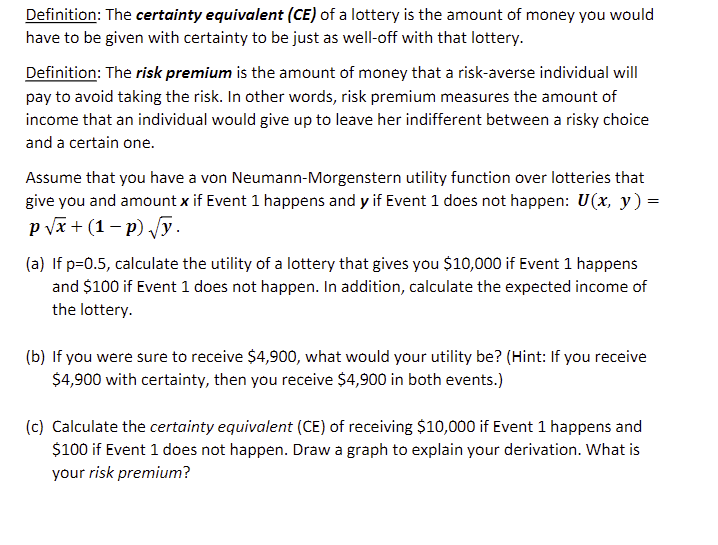Assume that you have a von Neumann-Morgenstern utility function over lotteries that give you and amount x if Event 1 happens and y if Event 1 does not happen: U(x, y) = p √x + (1-p) √y. (a) If p=0.5, calculate the utility of a lottery that gives you $10,000 if Event 1 happens and $100 if Event 1 does not happen. In addition, calculate the expected income of the lottery. (b) If you were sure to receive $4,900, what would your utility be? (Hint: If you receive $4,900 with certainty, then you receive $4,900 in both events.) (c) Calculate the certainty equivalent (CE) of receiving $10,000 if Event 1 happens and $100 if Event 1 does not happen. Draw a graph to explain your derivation. What is your risk premium?
Assume that you have a von Neumann-Morgenstern utility function over lotteries that give you and amount x if Event 1 happens and y if Event 1 does not happen: U(x, y) = p √x + (1-p) √y. (a) If p=0.5, calculate the utility of a lottery that gives you $10,000 if Event 1 happens and $100 if Event 1 does not happen. In addition, calculate the expected income of the lottery. (b) If you were sure to receive $4,900, what would your utility be? (Hint: If you receive $4,900 with certainty, then you receive $4,900 in both events.) (c) Calculate the certainty equivalent (CE) of receiving $10,000 if Event 1 happens and $100 if Event 1 does not happen. Draw a graph to explain your derivation. What is your risk premium?
Chapter7: Uncertainty
Section: Chapter Questions
Problem 7.7P
Related questions
Question

Transcribed Image Text:Definition: The certainty equivalent (CE) of a lottery is the amount of money you would
have to be given with certainty to be just as well-off with that lottery.
Definition: The risk premium is the amount of money that a risk-averse individual will
pay to avoid taking the risk. In other words, risk premium measures the amount of
income that an individual would give up to leave her indifferent between a risky choice
and a certain one.
Assume that you have a von Neumann-Morgenstern utility function over lotteries that
give you and amount x if Event 1 happens and y if Event 1 does not happen: U(x, y) =
p √x + (1-p) √y.
(a) If p=0.5, calculate the utility of a lottery that gives you $10,000 if Event 1 happens
and $100 if Event 1 does not happen. In addition, calculate the expected income of
the lottery.
(b) If you were sure to receive $4,900, what would your utility be? (Hint: If you receive
$4,900 with certainty, then you receive $4,900 in both events.)
(c) Calculate the certainty equivalent (CE) of receiving $10,000 if Event 1 happens and
$100 if Event 1 does not happen. Draw a graph to explain your derivation. What is
your risk premium?
Expert Solution
This question has been solved!
Explore an expertly crafted, step-by-step solution for a thorough understanding of key concepts.
This is a popular solution!
Trending now
This is a popular solution!
Step by step
Solved in 5 steps with 1 images

Knowledge Booster
Learn more about
Need a deep-dive on the concept behind this application? Look no further. Learn more about this topic, economics and related others by exploring similar questions and additional content below.Recommended textbooks for you

